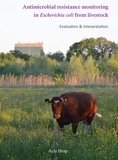Antimicrobial resistance monitoring in Escherichia coli from livestock
Evaluation & interpretation

Hesp, Ayla
- Promoter:
- Prof.dr D.J. (Dik) Mevius & prof.dr ir. G. (Gerdien) van Schaik
- Co-promoter:
- Dr K.T. (Kees) Veldman
- Date:
- November 11, 2021
- Time:
- 12:15 h
Summary
This thesis is about the monitoring of antimicrobial resistance (AMR) in livestock as public health hazard in indicator organism Escherichia coli. International legislation (2020/1729/EU) prescribes the sample design, laboratory methods for antimicrobial susceptibility testing (AST). The evaluation and quantitative interpretation of AMR monitoring results is not prescribed, but is challenging and will become more complex in future when even more data become available. Analyses can be improved for optimal evaluation and interpretation of AMR monitoring data. Therefore, the first aim of this thesis is to evaluate AMR monitoring results with statistical methods. The second aim is to improve interpretation of AMR monitoring outcome in commensal E. coli. The third aim is to assess whole genome sequencing (WGS) as alternative to culture-based AST to monitor AMR.
Time trends were modelled in AMR monitoring data of commensal E. coli from the Netherlands, 1998 to 2016, from broilers, slaughter pigs, veal calves, to evaluate if trends and trend changes as a result of interventions were observed. The rates of increase or decrease of AMR over time are captured in a model (Poisson regression). Since 2009, as a likely effect of antimicrobial use (AMU) interventions, a decrease over time for most antimicrobials is found in broilers and pigs, for some antimicrobials this decrease is faster than in others.
The applicability of six different evaluation tools for integrated surveillance was assessed by case studies in eight countries. Results show that although some tools cover relevant aspects better than others, there is not one best tool for evaluation of integrated AMR surveillance: the suitability of the tool depends on the evaluation objective. In general, more scientific expertise on evaluation of AMR monitoring from an integrated ‘One Health’ perspective is needed.
The need of policy makers was addressed to have a quick overview of AMR over multiple antimicrobial classes in an animal population. AMR monitoring outcome indicators were developed by a multivariate cluster analysis of AMR monitoring data from the Netherlands, 2007 to 2018, in broilers, slaughter pigs, veal calves, and dairy cows. This resulted in four clusters which are useful as monitoring outcome indicators, because they distinguish different levels of multidrug resistance (i.e. resistant to three or more antimicrobial classes) and indicate development of AMR over time and in the different animal sectors.
AMR was described in commensal E. coli from livestock in several European countries, and the correlation between AMR and AMU in several European countries, and the relationship with outcome indicators by the European Food Safety Authority was evaluated.
Furthermore, AMR monitoring is compared in commensal E. coli isolated from healthy animals with clinical resistant E. coli from diseased broilers in the Netherlands, 2014 to 2019. Despite differences in the two monitoring systems, resistant percentages are similar for most antimicrobials.
In the final part of the thesis, Bayesian latent class analysis was used to evaluate the accuracy of WGS (Illumina sequencing) versus culture-based AST to monitor AMR, without assuming one test as the gold standard. The additional benefits of WGS were described (apart from detection of resistance genes) in the same 150 commensal E. coli isolates from livestock. In the General discussion the meaning is described of the findings in this thesis for future evaluation and interpretation of AMR monitoring in livestock.